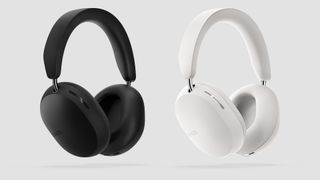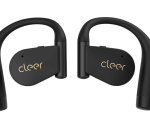Sonos has announced its first headphones, and they’re called Sonos Ace. They’re over-ear Bluetooth headphones, with support for Snapdragon Sound and aptX Lossless, Dolby Atmos spatial audio, active noise cancellation, USB-C lossless audio… and not with support for Sonos’ multi-room system.
We expected that Sonos headphones would have a feature like the Sonos Roam, where music auto-switches to Sonos Ace when you leave, and auto-switches back to your Sonos speakers when you return – and that you’d be able to choose them as a Wi-Fi music source from the Sonos app – but it’s not the case. Mostly, they work just like most of the best noise-cancelling headphones over Bluetooth, albeit at the premium end of things… however, they do have one big Sonos trick.
@techradar
♬ Funk Hip Hop Music(814197) – Pavel
They do have Wi-Fi built-in, and Sonos’ headphones can use it to connect to a Sonos soundbar, and thus play up all your TV’s audio from it, in head-tracked spatial audio. You can trigger this instantly with a button on the back, so you can watch TV silently, but in a virtual home theater, to avoid disturbing anyone else at home. This feature only works with Sonos Arc at launch, but will come to the Sonos Beam, Sonos Beam Gen 2 and Sonos Ray in the future.
They’re available to pre-order now, costing $449 / £449 / AU$699 and will launch on June 5, 2024. That price is obviously pretty darn premium, but puts them in line with the likes of the Bose QuietComfort Ultra Headphones or AirPods Max – and these are what the Sonos Ace really are in direct competition with, based on their full specs and features. So let’s dig into what those are.

What do the Sonos Ace offer?
As I mentioned above, these are over-ear Bluetooth headphones, with 40mm dynamic drivers (mounted at angles to ensure they’re parallel to your ears) inside some impressively slimline earcups. This is the same size of driver as the older-gen Sony WH-1000XM4, but not the Sony WH-1000XM5, which include a smaller 30mm driver in each earpiece.
The Sonos Ace stick out far less when you wear them than a lot of the competition, and feel extremely well-made. I got to try them out, and they were very comfortable in general, though I did find the area around my ears was starting to feel warm after a listening session, so we’ll need to wait for a full review to see if that’s common. At 11oz / 312g, they’re not super-light, (the Sony XM5 weigh 250g) but they’re far from heavy for well-specced headphones. The earpads are replaceable, if they become worn over time.
They come with a hard case that’s made heavily from recycled materials, and is also impressive slimline – they look like good travel headphones, potentially. It has a little pouch for your cables, too.

For connections, you’ve got Bluetooth 5.4 with multi-point pairing for two devices, plus Snapdragon Sound with aptX Lossless support, and USB-C for lossless audio (including support for Apple Lossless files from an iPhone/iPad/Mac when cabled). There’s no 3.5mm port, but there’s a USB-C-to-3.5mm cable in the box. Oh, and there’s Wi-Fi, but that’s only used for the soundbar connection.
They support Dolby Atmos, and not just when connected to a Sonos soundbar – they’ll play Dolby Atmos spatial audio from any Bluetooth device that supports it, so that includes iPhones. And they’ll do head-tracked Dolby Atmos spatial audio from those devices, using a Dolby-developed tracking system.
They promise to last for 30 hours with ANC turned on, and claim to deliver three hours’ use from a three-minute charge from flat. If the claim holds true, that’s good stamina with active noise cancellation deployed, and would put them up among the best over-ear headphones we’ve tested for battery life.
They’re controlled using a ‘Content Key’ button/slider combo on the right earcup – slide it up and down to change volume, and click it to play/pause/skip tracks. A button below it switches to TV audio, or back to Bluetooth.
You won’t need the Sonos app to set them up or use them – but you will need the companion app for the head-tracked spatial audio setup, or to change the EQ. Sonos is also promising a ‘TrueCinema’ mode is coming. This, says Sonos, will actually tweak the spatial audio sound in TV mode to sound more like a home theater system specifically in the space of your living room, making it more convincing to the brain, rather than sounding like it’s from a generic giant room. But that won’t be available at launch.

The headphones have an auto-pause feature when you remove them, but there’s no Find My support listed, which is a bit of a shame for a pair of headphones you really wouldn’t want to lose.
Their feature set is extremely similar to both the Bose QuietComfort Ultra Headphones and the AirPods Max – but the Sonos Ace has support for the key features lacking in each of those. They have the longer battery life, broad aptX support, lossless USB-C connection, and true Dolby Atmos spatial audio we wish the Bose had. They have the lossless Bluetooth and USB-C options, gentler fit, and Android support that we wish the AirPods Max had.
From my early time with them, the sound quality definitely seemed worth the price, and the noise cancellation seemed solid, so perhaps they can knock the Bose Ultra from being my personal pick among the best wireless headphones.
However, there are some disappointments, especially for Apple users, or anyone who went really deep into the Sonos ecosystem. There’s no wireless lossless audio support from iPhone – aptX isn’t supported there. If Sonos had enabled the headphones to work with its Wi-Fi streaming, you could get lossless from Apple Music to them that way.
And if you’ve invested in way to get one of the best turntables into your Sonos system (using a Sonos Amp or Sonos Port, or plugging one into the Sonos Era 100, or buying a Sonos-ready turntable such as the Victrola Stream Carbon) you might expect to be able to listen to it via your Sonos headphones… but again, without support for the standard Sonos multi-room Wi-Fi system, that’s not the case.
Sonos said it will be listening to feedback from customers about this (though it’s already got a lot of customer feedback on its hands about its latest app update), and that it’s possible that option to use the Sonos Ace with its multi-room system could come in the future – but it’s not currently planned.
Still, outside of the Sonos hardcore, the Sonos Ace could have big appeal for those not put off by the big price tag – we’ll bring you a full review as soon as we’re able.









